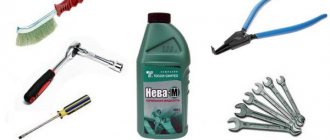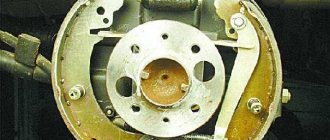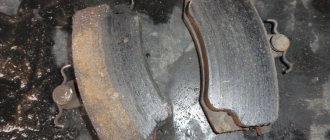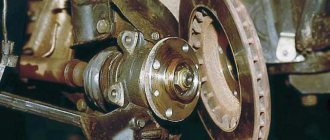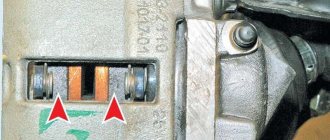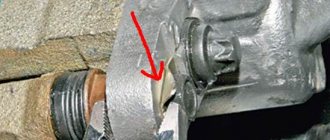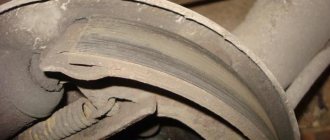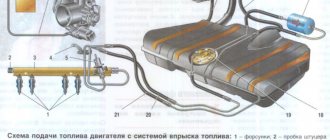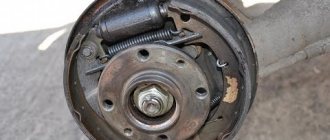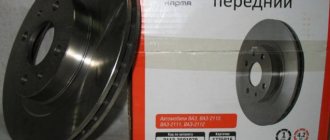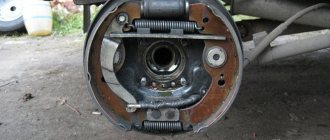Replacing the front brake hose of VAZ 2106, VAZ 2107, VAZ 2109, VAZ 2110, VAZ 2114, VAZ 2115
The braking system is a system that the driver must pay special attention to, since the operation of its elements directly affects the safety of the vehicle. To study the design and help in servicing the brake system, the website has a section called - Brake system design , in which you can disassemble this system into its component parts in more detail.
As for this article, it is devoted to a topic called - How to replace brake hoses of a VAZ 2106, VAZ 2107, VAZ 2109, VAZ 2110, VAZ 2114, VAZ 2115, Lada Kalina, VAZ 2170 with your own hands.
Many motorists believe that replacing brake hoses does not deserve a separate topic, since it is not at all difficult, but for novice motorists, I think this article will be useful.
After all, you will agree that no matter what job a person takes on, there will always be nuances that would be better to learn from advice than from your own bitter experience.
I would highlight several basic questions that a beginner should pay attention to when replacing brake hoses on a VAZ 2106, VAZ 2107, VAZ 2109, VAZ 2110, VAZ 2114, VAZ 2115, Lada Kalina, VAZ 2170:
- Which brake hose manufacturer is best?
- What tools are needed to replace brake hoses?
- Consistently work on replacing brake hoses.
We will try to consider all these questions in this article. In order to make your work easier, just find on the Internet the answer to the question - how to replace the brake hose on a VAZ 2106, VAZ 2107, VAZ 2109, VAZ 2110, VAZ 2114, VAZ 2115, Lada Kalina, VAZ 2170.
So, let's start studying information on how to replace the front brake hoses of a VAZ 2106, VAZ 2107, VAZ 2109, VAZ 2110, VAZ 2114, VAZ 2115, Lada Kalina, VAZ 2170.
Tools for replacing brake hose:
- Open-end and ring wrenches for 8, 14, 15.
- Socket wrench 8.
- Special split key and crimp key for 10.
- Hammer.
- Metal brush.
- Don't forget to get WD-40 fluid (it currently costs about 80 hryvnia, but you will need it in the future).
- Transparent bottle for easy brake bleeding.
- It is better to carry out work on replacing brake hoses with a partner.
What brake hoses should I buy and what spare parts should I buy to replace the brake hoses?
Brake hoses have proven themselves well , they are of good quality and a little expensive. If you want to save a little, you can buy brake hoses produced by DAAZ , which are also of good quality.
You should also buy copper washers 1.5 mm thick, brake fluid, which is necessary for bleeding the brake system. I recommend buying brake fluid DOT 4 400 grams.
Which spare parts are better
The main problem when choosing brake hoses is the saturation of the market with counterfeit parts of low quality. Such eyeliners do not last long, quickly become covered with cracks or begin to leak near the pressed tips literally a week after installation. How to choose the right rubber pipes:
An additional sign of a quality product is 2 pressing contours instead of one. Counterfeit pipes are not made with such care.
Trusted brands that produce brake pipes of decent quality:
Hoses from the Balakovo plant are considered original. The parts are sold in transparent packaging with a hologram, the marking is in relief (molded along with the rubber product), and not a colored inscription with paint.
Along with a set of front pipes, it is worth buying 4 new O-rings made of copper 1.5 mm thick, since the old ones are probably flattened from strong tightening. It also doesn’t hurt to make sure there are fixing brackets screwed to the calipers - many drivers don’t bother installing them.
Video: how to distinguish counterfeit parts
Replacing brake hoses on VAZ 2101-VAZ 2107
Welcome! Brake hoses are an important part of the braking system and in no case should you skimp on them, and even this is stupid, there have already been many cases when the brakes of cars failed, many people think that this happens mainly in trucks, but this rarely happens with cars, in fact, this is a deep misconception, it’s just easier to stop passenger vehicles than trucks, which is why there are much fewer accidents with passenger cars (Below we have attached a video in which the brake system of a car failed), by the way, one of the main reasons is the brake hoses, and so the main brake cylinder (it fails less often), the hoses break from time to time and therefore even in books it is written that it is extremely undesirable to operate a car with hoses that are more than 3 years old, and all because the rubber ages and it is stronger subject to deformation, unlike when the tires are completely new (i.e. the brake hoses have been replaced in the car).
Note! To replace the brake hoses, you will need: A special wrench, which we strongly recommend that you buy, because the nuts of the brake pipes turn sour over time and it becomes almost impossible to unscrew them with a regular wrench, but with a special wrench this is as easy as shelling pears (It is indicated by the red arrow on photo below), in addition to this key, stock up on good brake hoses, pliers, screwdrivers and a set of all kinds of keys, which will include keys “10”, “14”, “15”, “17”!
Summary:
Where are the brake hoses located? There are three hoses in total, two in the front and one in the rear, you will most likely have a question, why one in the rear and two in the front (We are just often asked about this), we explain, in the front part the brake pipes immediately go hoses (see left photo), when in the rear part this is simply not needed, there is just one brake hose (see right photo) and it is connected to a tee on the rear axle housing and from this tee, brake pipes already come out and go on both rear wheels of the car.
When do you need to change brake hoses? Any motorist has days when he has to crawl under the car, driving it into an inspection hole, and there are also times when a wheel is removed (for example, to replace it), so when you are planning to go to the pit and when you crawl under the car from below, be sure to take a look at all three hoses, whatever else and devote to them, they must be in good condition and not have cracks and under no circumstances should brake fluid flow through them, if you ever feel the urge to remove one or both front wheels, then also look at the brake hoses (When the front wheels are removed, the hoses are very accessible) they should not have cracks, should not leak and in general there should not be any deformation on them, but this is all visual, you can understand that the hose has broken only when If the brake reservoir is empty and the car starts to slow down worse, for example, the rear brake hose of the car breaks, then you can immediately assume that the rear brakes will not work, the same goes for the front hose(s), if it(s) break, then only the rear brakes and will work, to such consequences (That the brake hoses break), try not to let this happen and change the brake hoses on time, if you follow the recommendations of the books and the factory, they say: “Brake hoses need to be changed after every 60 thousand km or after 3 years of operation of the car , otherwise they wear out and their rubber ages, due to which it is subject to deformation much more easily and ultimately the rubber may simply burst.”
How to replace the speedometer cable on a VAZ 2101-VAZ 2107?
Note! The brake system has circuits, on the classic they are located transverse to each other, that is, the rear brake circuit (Both rear wheels) and the front brake circuit (Both front wheels), as we said above, if the rear circuit hose breaks, for example, then both the rear wheels stop braking (the circuit completely fails) and vice versa, but we’re not talking about that, we want to say a few words about pumping the brakes, when it comes to the brake system, pumping the brakes is always affected, for pumping you need brake fluid, so stock up on it in advance , also take into account the very contours of the brake system, based on them, when working with the front part (For example, you are changing the brake hoses in the front part), bleed only it, when working with the rear part (For example, you are about to change the rear brake hose), bleed the rear ones You don’t even have to get the wheels close to the front end, don’t forget about it!
1. Let’s start with the front brake hoses, even if you have them intact and do not need to be replaced, you don’t need to immediately scroll further and look for information on replacing the rear brake hose (It’s given in paragraph 2), because the hoses (both front and rear) ) are replaced in the same way and after reading this paragraph, you will know what we did not indicate in paragraph 2, well, let's start! To replace the hose at the front, remove the wheel (How to remove a wheel, read the article: “Replacing wheels in a car”) and use a wrench to unscrew the bolt that secures the hose to the caliper (see photo below), then remove the bolt and there will be copper washers on it (Two, indicated by red arrows), they must be replaced with new ones, they play the role of some kind of seals, and when installing old ones (Compressed washers), it is possible that brake fluid will flow through the place where the hose is connected to the caliper.
How to change front brake hoses on a VAZ 2107
Good afternoon dear friends. The brake system of any car includes brake lines and rubber hoses. The latter have the ability to “crack” during operation, losing their tightness. If there is no tightness in the system, brake fluid leaks out, which means there will be no effective brakes, resulting in an accident or expensive body repairs.
To avoid this, you need to monitor the condition of the brake hoses. If cracks and breaks are observed on their surface, replace them urgently. Today we will learn how to independently change the front brake hoses on a VAZ 2107 , and a specialist will show on video how to do it correctly, reveal all the secrets and nuances of replacing them using the example of a Lada 2106.
General structure of the braking system
The schematic diagram of the vehicle includes the following elements:
- brake mechanism;
brake drive.
The brake mechanism implements the function of braking - achieving the torque that is necessary to reduce the speed of movement or stop.
The VAZ-2107 is equipped with a classic version of friction mechanisms based on friction force.
Their design can be represented by the following two options:
- disc (compression mechanism) front brakes;
- drum (unclosing mechanism) rear brakes.
A brake actuator is needed to control the braking mechanisms. There are mechanical, pneumatic, hydraulic, electric and combined operating principles of drives. The VAZ-2107 uses the most common hydraulic principle, based on the action of brake fluid (a special oily substance).
The hydraulic drive circuit includes:
- brake pedal (to control the hydraulic drive);
- vacuum booster (to create additional force when pressing the pedal);
- master brake cylinder with an expansion tank (to ensure an increase or decrease in fluid pressure in the dual-circuit system, as well as to replenish fluid);
- wheel (or working) cylinders (to bring the control functions of the pedal to the brake mechanism);
- rear brake pressure regulator (to adjust the braking force as the vehicle weight increases);
- pipelines and hoses (for placing and moving brake fluid throughout the system).
The implementation of braking functions in the VAZ-2107 (as well as in related models - sedans 2101, 2103, 2105, 2106 and station wagons 2102, 2104) involves the use of two parallel independent hydraulic drive circuits. In the event of a malfunction of one circuit, the braking functions are redistributed to the second.
How does it all work
The principle of operation of the VAZ 2107 brake system can be briefly described as follows:
- The driver, while driving along the highway, decides to slow down or stop.
- To do this, he presses the brake pedal with his foot.
- This force immediately falls on the valve mechanism of the amplifier.
- The valve slightly opens the supply of atmospheric pressure to the membrane.
- The membrane acts on the rod through vibration.
- Next, the rod itself exerts pressure on the piston element of the master cylinder.
- The brake fluid, in turn, begins to move the pistons of the working cylinders under pressure.
- Due to pressure, the cylinders are expanded or pressed (depending on whether disc or drum brakes are on a given vehicle axle). The mechanisms begin to rub the pads and discs (or drums), due to which the movement speed is reset.
Required Tools
- Special split wrench “8/10” for unscrewing brake pipes
- Open-end wrench "17"
- Socket wrenches for “14” and “10” or heads for the same bolts
- Pliers or round nose pliers
To replace the front brake hoses on a classic, you will need a narrow metal brush to clean the bolted joints from dirt and a rubber cap to “plug” the metal tube. This cap can be taken from the bleeder fitting of the working brake cylinder. We'll talk about how to use it below. I advise you to buy new copper sealing washers in the amount of 4 pieces.
Purpose of flexible pipes
The contours of the VAZ 2107 liquid brakes are made of metal tubes leading from the master cylinder (abbreviated as GTZ) to all wheels. It is impossible to connect these lines directly to the working cylinders, since the wheel brake mechanisms are constantly moving relative to the body - the chassis absorbs unevenness, and the front wheels also turn left and right.
To connect rigid tubes to the calipers, flexible connections are used - brake hoses made of moisture-resistant reinforced rubber. The “seven” has 3 pipes - two on the front wheels, the third supplies fluid to the brake pressure regulator of the rear axle. Short thin hoses between the expansion tank and the gas turbine engine do not count - they do not have high pressure, spare parts rarely become unusable.
Flexible eyeliner consists of 3 elements:
The first end of the hose, connecting to the circuit tube, is always attached with a fixing bracket to a special bracket on the body. On the rear axle the second tip remains free, on the front wheels it is additionally fixed to the calipers with overhead brackets. To prevent liquid from seeping through the threaded connection, 2 copper sealing washers are put on the bolt.
Please note: the hose eyelet for the front wheels is made at an angle relative to the longitudinal axis of the pipe, as shown in the drawing.
How to unscrew an old brake hose
1. Carefully clean with a metal brush all the bolted connections that we will unscrew: the fastening of the brake hose clamp to the working cylinder, the bolt connecting it to the cylinder, the joint between the hose and the brake pipe and their fixing plate. These places are located in the wheel area and serve as an excellent storage area for road dirt and rust. This must be done so that there are no problems when dismantling all these parts.
2. Unscrew the cap from the brake fluid reservoir and instead put on a plastic bag and screw the cap onto the clutch reservoir. This is necessary to seal the brake system. Having done this “trick”, you will not lose much “brake fluid” when replacing the front brake hoses on a classic.
3. Using pliers or round nose pliers, remove the fixing bracket from the junction of the tube and hose. It is needed to prevent spontaneous unscrewing of the fitting.
4. Using a special split wrench set to “10”, unscrew the metal tube from the hose fitting, fixing it with the wrench set to “17”.
Important! When unscrewing the tube fitting, make sure that it does not rotate with the fitting. There is a chance to break it. To prevent this, you need to “soak” the contact area with WD-40 and develop it by slightly swinging the key in the direction of opening and closing. If this does not help, then remove the opposite end of the front brake hose, fix the fitting, and use a key to “17” to unscrew the hose.
Having removed the hose from the metal tube, close its fitting with the cap mentioned above. This will prevent loss of brake fluid.
5. To unscrew the brake hose from the working cylinder, you need to use a “10” key to unscrew the bolt securing the hose clamp from the wheel hub. Remove the fixing bracket.
6. Using a spanner wrench or a 14mm socket, unscrew the bolt securing the hose from the brake cylinder.
It is recommended to replace the old copper sealing washers with new ones. You will see them when you remove the fastening bolt from the hose fitting and the working cylinder seat. They seal the joint, so there should be two of them - one on top under the bolt head, the second on the bottom, between the cylinder and the fitting.
Removal is complete; reassembly is done in reverse order. After this, it is recommended to bleed the brake system; how to do this was described in detail in the previous article. We check the connection points for leaks and tighten them if necessary.
Video, replacing the front brake hoses of VAZ 2106, VAZ 2107:
How to repair brake pipes
This process requires the car enthusiast to have extensive locksmith skills and the ability to use special tools. Repairs are carried out in cases where it is not possible to replace the damaged line; it involves saving money on the purchase of a new pipe system and extends the service life of the old one.
To carry out repairs you must:
1. Unscrew the damaged tube from the cylinder or brake caliper.
2. After disconnecting, it is necessary to cut off the damaged area using a pipe cutter.
3. Clamp the tube 50 millimeters from the edge of the cut and chamfer the edge of the tube using a drill.
4. Remove all that remains of the chips and insert a fitting intended for connecting the tube to the brake operating mechanism into the cut area.
5. Insert the end of the tube into the special equipment and flare it. The main line that has undergone repairs must be purged with compressed air. And only after this is it installed with a working mechanism or another pipeline system using an adapter.
As for the length of the tube, this parameter depends on the car model. On some cars, the brake pipes have a reserve that allows you to shorten the pipe and reconnect it to the working mechanism. The metal from which the brake tube is made is flexible, so there should not be any difficulties with its position.
Installation nuances
- The fitting of the new hose on the caliper side must be screwed on with a special cut-out downwards. Otherwise, it may rest against the brake pipe of the cylinder and break it.
- If, when dismantling the old front brake hose, the tube fitting was rotated along with the tube, then installation of a new one begins by screwing it to the iron tube. We fix it with a split wrench, and with an open-end wrench we twist the hose and tighten it.
- We tighten all threaded connections carefully so as not to strip the threads. We clearly get into it and try. They should twist without much effort. If you feel that it is difficult to “go”, then separate them and try to get clearly into the thread again.
- You need to tighten everything without any hassle, the threads are small, and the metal is fragile, you can tear it off and then nothing will be able to eliminate the brake fluid leak unless you pull the fittings and bolts.
How to change a brake hose on a VAZ 2106
Hello, in this article you will learn how to replace brake hoses on a VAZ 2101, 2102, 2103, 2104, 2105, 2106, 2107 in a garage. Brake hoses are an integral part of the brake system, they are a flexible connection between the brake pipe and the caliper. Hoses are constantly exposed to various influences. When braking, a huge amount of pressure is generated inside the hose, which is necessary to move the brake cylinder, which moves the brake pads. From the outside, the hose is exposed to dirt, snow, sand, water, and at the same time, it also bends all the time while the wheels rotate. As we can see, brake hoses are constantly in difficult conditions, so from time to time they need to be inspected for cracks, because if cracks appear, they can disperse under pressure and brake fluid will flow out, which means that the effectiveness of the braking system will sharply deteriorate and in a short time the brakes will fail altogether. To replace brake hoses you will need: pliers, open-end wrenches 10, 14 and 17. The cost of brake hoses on the automobile market starts from 300 rubles, but it is better to buy better hoses.
First of all, jack up the car and remove the wheel. Then we take pliers and remove the locking plate, it is located at the end of the brake hose
Next, use a 17 wrench to hold the brake hose, and use a 10 wrench to unscrew the brake pipe (after unscrewing, brake fluid will flow from the tube, plug it, for example, the cap from the fitting for bleeding the brake system)
Now you need to unscrew the locking plate fastenings on the brake caliper
The next step is to unscrew the bolt securing the second end of the brake hose using a 14mm wrench
We do the same on the other side; if necessary, install the brake hose in the reverse order. Since air has entered the brake system, it will need to be bled.
We hang and remove the front wheel.
When to change hoses
By regularly diagnosing the system, it is easy to understand when it is time to change spare parts:
- The appearance of cracks in the braid.
Cracks in the braid
To see them, just bend it a little. The size of the crack does not matter; even the smallest tear length can quickly lead to serious wear. - The appearance of liquid near the tips.
- Violation of the integrity of the part, the appearance of frayed areas.
Integrity violation - If the brake fluid starts leaving the reservoir too quickly.
- If the car has just been purchased secondhand.
Any of these reasons is a good reason to replace old spare parts with new ones.
Brake hoses
Video diagnostics of flexible brake pipes
↑ Remove the old brake hose
- Using pliers, remove the bracket that secures the brake hose in the body bracket.
- While holding the hose tip from turning with a 17 wrench, use a 10 wrench to unscrew the brake pipe fitting.
- We remove the brake hose from the bracket, and put a protective cap on the bleeder fitting on the brake pipe to prevent brake fluid leakage.
- Using a 10mm wrench, unscrew the bolt securing the bracket that secures the brake hose and remove it.
- Using a 14mm socket, unscrew the bolt securing the brake hose and remove the hose.
Front wheel brake hose - replacement
The work is shown using the example of replacing the brake hose of the right wheel.
To complete the work, you will need an assistant, as well as a special 10 mm wrench for brake pipes, a transparent vinyl tube of a suitable diameter, a container for draining brake fluid, and fresh brake fluid (see “Operating fluids”).
1. We prepare the car for operations (see “Preparing the car for maintenance and repair”).
2. Remove the front wheel (see “Wheel - replacement”).
3. Using pliers, remove the bracket securing the brake hose.
4. Use a special 10 mm wrench to unscrew the brake pipe fitting, holding the hose tip with a 17 mm wrench.
5. To reduce brake fluid losses, put a protective cap on the end of the tube (from the brake cylinder bleeder fitting) and remove the hose tip from the bracket on the body.
6. Using a 10 mm deep socket wrench, unscrew the bolt securing the brake hose fixing bracket.
7. Remove the fixing bracket.
8. Using a 14 mm socket wrench with an extension, unscrew the bolt fitting securing the brake hose tip.
9. Remove the hose with the bolt and copper sealing washers.
1. Replace the copper sealing washers.
2. Install the new hose in the reverse order.
3. Similarly, replace the hose on the opposite side.
4. Bleed the front circuit of the hydraulic brake drive (see “Hydraulic brake drive - pumping and replacing brake fluid”).
